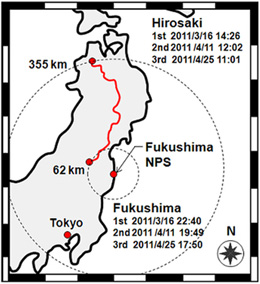Research Abstract
福島原発事故によって人為的に高められた空間線量率の経時変動
The time variation of dose rate artificially increased by the Fukushima nuclear crisis
2011年9月7日 Scientific Reports 1 : 87 doi: 10.1038/srep00087

2011年3月11日の東日本大震災後に、福島第一原子力発電所から放射性核種の放出が始まった。この福島第一原発の北西を通る高速道路に沿って、また高度に汚染されたことがわかっている原発周辺地域で、2011年3月と4月に、大気中の空間線量率の走行サーベイを行った。高速道路沿い、すなわち原発から比較的遠い地点の線量率は3月11日の前よりも後のほうが高く、場所によっては桁違いに上昇しており、福島第一原発から放出の繰り返しがあったことが示唆される。高汚染地域(浪江町)での大気中の最大空間線量率は36 µGy h−1であった。浪江町から福島市、郡山市、二本松市などへ避難した住民の累積外部被ばく線量は最大で68 mSvと推定された。放射線防護の観点から、住民の避難は正当だったと考えられる。
- 弘前大学大学院保健学研究科
- 弘前大学被ばく医療総合研究所
- 鹿児島大学大学院医歯学総合研究科
A car-borne survey for dose rate in air was carried out in March and April 2011 along an expressway passing northwest of the Fukushima Dai-ichi Nuclear Power Station which released radionuclides starting after the Great East Japan Earthquake on March 11, 2011, and in an area closer to the Fukushima NPS which is known to have been strongly affected. Dose rates along the expressway, i.e. relatively far from the power station were higher after than before March 11, in some places by several orders of magnitude, implying that there were some additional releases from Fukushima NPS. The maximum dose rate in air within the high level contamination area was 36 µGy h−1, and the estimated maximum cumulative external dose for evacuees who came from Namie Town to evacuation sites (e.g. Fukushima, Koriyama and Nihonmatsu Cities) was 68 mSv. The evacuation is justified from the viewpoint of radiation protection.

